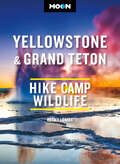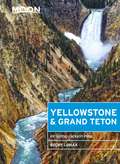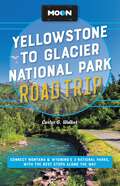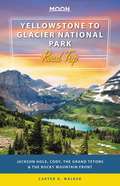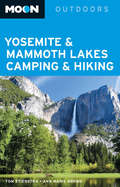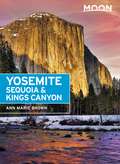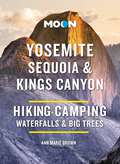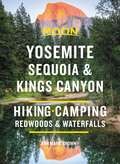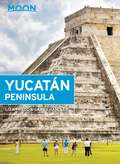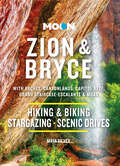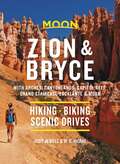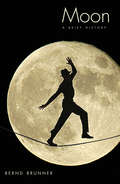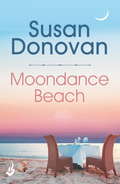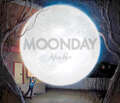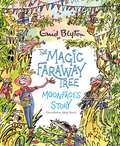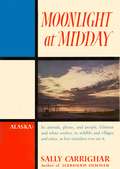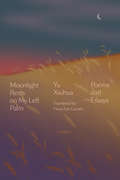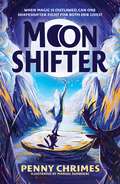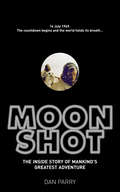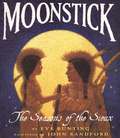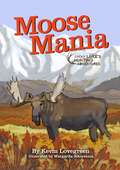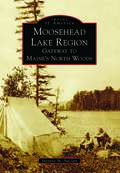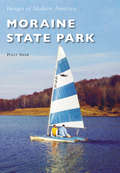- Table View
- List View
Moon Yellowstone & Grand Teton: Hiking, Camping, Wildlife (Moon National Parks Travel Guide)
by Becky Lomax Moon Travel GuidesForge your way through forests, across mountain peaks, past geysers, and more with Moon Yellowstone & Grand Teton. Inside you'll find:Flexible itineraries: Adventure-packed ideas ranging from one day in each national park to a week-long road trip covering both The best hikes in Yellowstone & Grand Teton: Detailed descriptions, mileage and elevation gains, and backpacking options Experience the outdoors: Marvel at the steam-spewing Old Faithful geyser or take a horseback ride to panoramic lakeside views. Hike through alpine forests to rushing waterfalls and catch a glimpse of wild bison, elk, wolves, or bears. Bask in the colorful radiance of Grand Prismatic Spring or stroll the boardwalks along Mammoth Hot Springs. Climb to Inspiration Point for breathtaking views of Jackson Hole and Jenny Lake, explore the quirky nearby towns, or discover the best spots to hit the slopes during the winter season How to get there: Up-to-date information on gateway towns, park entrances, park fees, and tours Where to stay: Campgrounds, resorts, and more both inside and outside the park Planning tips: When to go, what to pack, safety information, and how to avoid the crowds, with full-color photos and detailed maps throughoutExpertise and know-how: Explore both national parks with outdoors expert and former park guide Becky Lomax Helpful background on the indigenous cultures, landscape, plants and animals, and history of the region Find your adventure in Yellowstone & Grand Teton National Parks with Moon. Visiting more of North America's national parks? Try Moon Glacier National Park or Moon USA National Parks. About Moon Travel Guides: Moon was founded in 1973 to empower independent, active, and conscious travel. We prioritize local businesses, outdoor recreation, and traveling strategically and sustainably. Moon Travel Guides are written by local, expert authors with great stories to tell—and they can't wait to share their favorite places with you. For more inspiration, follow @moonguides on social media.
Moon Yellowstone & Grand Teton: Including Jackson Hole (Travel Guide)
by Becky LomaxFind Your Adventure with Moon Travel Guides!Forge your way through forests, across mountain peaks, past geysers, and more with Moon Yellowstone & Grand Teton. Inside you'll find:Itineraries for every timeline, budget, and travel style, ranging from one day in each national park to a week-long road trip covering bothThe top activities and unique ideas for exploring each park: Marvel at the steam-spewing Old Faithful geyser, or take a horseback ride to panoramic lakeside views. Hike through alpine forests to rushing waterfalls, and catch a glimpse of wild bison, elk, wolves, or bears. Climb to Inspiration Point for breathtaking views of Jackson Hole, explore the quirky nearby towns, or discover the best spots to hit the slopes during the winter seasonStrategies for getting to the parks and traveling between them, with suggestions on where to stop along the way to eat, rest, or exploreExpert tips for hiking, backpacking, mountain biking, kayaking, and more, plus essential packing and health and safety informationDetailed hike descriptions with individual trail maps, each marked by duration, elevation change, and moreValuable insight from Yellowstone expert and seasoned explorer Becky LomaxHonest advice on where to stay inside and outside the parks, including campgrounds, cabins, guest ranches, and resortsUp-to-date information on park fees, passes, and reservationsFull-color photos and detailed maps of each national parkCoverage of gateway cities and towns, including Jackson Hole, Big Sky, Red Lodge, Cody, Lander, and DuBoisRecommendations for families, seniors, solo travelers, international visitors, travelers with disabilities, and traveling with petsThorough background on the wildlife, weather, terrain, hazards and personal safety, and history Experience the parks your way with Moon Yellowstone & Grand Teton's practical tips, boundless activities, and reliable expertise.For more of the Rockies, check out Moon Montana & Wyoming, Moon Colorado, or Moon Idaho. Checking out more national parks? Try Moon Glacier National Park.
Moon Yellowstone to Glacier National Park Road Trip: Connect Montana & Wyoming's 3 National Parks, with the Best Stops along the Way (Travel Guide)
by Carter G. WalkerFrom stunning waterfalls, glaciers, and geysers to wide open spaces, answer the call of the wild with Moon Yellowstone to Glacier National Park Road Trip. Inside you'll find:Flexible itineraries: Drive the entire two-week route or explore the region on shorter trips to Glacier, Yellowstone, or Grand Teton Eat, sleep, stop and explore: With lists of the best hikes, views, places for wildlife-watching, and more, you can watch Old Faithful from Observation Point, drive the 50-mile Going-to-the-Sun Road, spot everything from bighorn sheep to bears on a wildlife tour of Yellowstone's Lamar and Hayden valleys, and kick back with a craft beer in Bozeman Outdoor adventures: Hike the trails in Glacier or ski in Whitefish. Admire the reflection of the Grand Tetons as you kayak Jenny Lake or set up camp and stargaze late into the night The best hikes: Detailed descriptions, trail maps, mileage and elevation gains, and backpacking options Maps and driving tools: Easy-to-use maps keep you oriented on and off the highway, along with site-to-site mileage, driving times, detailed directions for the entire route, and full-color photos throughout Local expertise: Former wilderness guide Carter G. Walker shares her deep love of the region Planning your trip: Know when and where to get gas, how to avoid traffic, tips for driving in different road and weather conditions, and suggestions for LGBTQ travelers, seniors, and road-trippers with kids Coverage of Yellowstone, Grand Teton and Glacier National Parks, Bozeman, Jackson Hole, Cody, Whitefish, and more With Moon Yellowstone to Glacier National Park Road Trip's practical tips, flexible itineraries, and local know-how, you're ready to fill up the tank and hit the road. Spending more time in the parks? Check out Moon Glacier National Park or Moon Yellowstone & Grand Teton. Want to extend your adventure? Check out Moon Montana & Wyoming.About Moon Travel Guides: Moon was founded in 1973 to empower independent, active, and conscious travel. We prioritize local businesses, outdoor recreation, and traveling strategically and sustainably. Moon Travel Guides are written by local, expert authors with great stories to tell—and they can't wait to share their favorite places with you. For more inspiration, follow @moonguides on social media.
Moon Yellowstone to Glacier National Park Road Trip: Jackson Hole, the Grand Tetons & the Rocky Mountain Front (Travel Guide)
by Carter G. WalkerFrom stunning waterfalls, glaciers, and geysers to wide open spaces begging to be explored, answer the call of the wild with Moon Yellowstone to Glacier National Park Road Trip. Inside you'll find:Maps and Driving Tools: Easy-to-use maps keep you oriented on and off the highway, along with site-to-site mileage, driving times, detailed directions for the entire route, and full-color photos throughoutEat, Sleep, Stop and Explore: With lists of the best hikes, views, places for wildlife-watching, and more, you can watch Old Faithful from Observation Point, drive the 50-mile Going-to-the-Sun Road, spot everything from bighorn sheep to bears on a wildlife tour of Yellowstone's Lamar and Hayden valleys, and kick back with a craft beer in BozemanOutdoor Adventures: Hike the trails in Glacier or ski in Whitefish. Admire the reflection of the Grand Tetons as you kayak Jenny Lake or set up camp and stargaze late into the nightThe Best Hikes: Detailed descriptions, trail maps, mileage and elevation gains, and backpacking optionsFlexible Itineraries: Drive the entire two-week route or explore the region on shorter trips to Glacier, Yellowstone, or Grand TetonLocal Expertise: Former wilderness guide Carter G. Walker shares her deep love of the regionHow to Plan Your Trip: Know when and where to get gas and how to avoid traffic, plus tips for driving in different road and weather conditions and suggestions for LGBTQ travelers, seniors, and road-trippers with kidsCoverage of Yellowstone, Grand Teton and Glacier National Parks, Bozeman, Jackson Hole, Cody, Whitefish, and moreWith Moon Yellowstone to Glacier National Park Road Trip's practical tips, flexible itineraries, and local know-how, you're ready to fill up the tank and hit the road.Spending more time in the parks? Check out Moon Glacier National Park or Moon Yellowstone & Grand Teton. Want to extend your adventure? Check out Moon Montana & Wyoming.
Moon Yosemite & Mammoth Lakes Camping & Hiking
by Ann Marie Brown Tom StienstraCalifornia residents Tom Stienstra and Ann Marie Brown extend travelers their firsthand advice on how to find the best places to camp and hike in this vast region, from the pristine meadows and towering granite formations of Yosemite Valley to the alpine waters of the Mammoth Lakes area. Along with their in-depth coverage, Stienstra and Brown offer "best-of" lists-including Best for Fishing, Best for Families, and Best Hikes with a View-ensuring that both outdoors beginners and experts will find the campgrounds and trails to match their skill levels and interests. Complete with clear directions to each location, detailed destination descriptions, difficulty and quality ratings for each hike, and helpful maps,Moon Yosemite & Mammoth Lakes Camping & Hikingprovides campers and hikers with all the necessary tools to head outdoors.
Moon Yosemite, Sequoia & Kings Canyon (Travel Guide)
by Ann Marie BrownExplore granite domes, thundering waterfalls, and towering trees: Moon Yosemite, Sequoia & Kings Canyon reveals the best of these stunning national parks. Inside you'll find:Flexible Itineraries: Unique and adventure-packed ideas for day hikers, winter visitors, families with kids, campers, and more The Best Hikes in Each Park: Detailed hike descriptions, individual trail maps, mileage and elevation gains, and backpacking optionsExperience the Outdoors: Ride the open-air tram through Yosemite Valley or hike downhill from Glacier Point past roaring waterfalls. Drive the legendary Generals Highway or take a scenic bike ride to pristine lakes (and yes, more waterfalls!). Go for a horse-drawn wagon ride on a pioneer history tour or take a rock-climbing lesson. Walk among the goliaths of Sequoia's Giant Forest and stop at a historic lodge for dinner and a well-deserved drinkHow to Get There: Up-to-date information on traveling between the parks, gateway towns, park entrances, park fees, and toursWhere to Stay: From campgrounds and rustic lodges to the Majestic Yosemite Hotel, find the best spots to kick back, both inside and outside the parksPlanning Tips: When to go, what to pack, safety information, and how to avoid the crowds, with full-color photos and detailed maps throughoutExpertise and Know-How from seasoned explorer and outdoor expert Ann Marie BrownFind your adventure in Yosemite, Sequoia, and Kings Canyon national parks with Moon.Visiting more of North America's incredible national parks? Try Moon USA National Parks or Moon Death Valley National Park. Hitting the road? Try Moon California Road Trip.
Moon Yosemite, Sequoia & Kings Canyon: Hiking, Camping, Waterfalls & Big Trees (Moon National Parks Travel Guide)
by Ann Marie Brown Moon Travel GuidesExplore granite domes, thundering waterfalls, and towering trees: Moon Yosemite, Sequoia & Kings Canyon reveals the best of these stunning national parks. Inside you'll find:Flexible Itineraries: Unique and adventure-packed ideas for day hikers, winter visitors, families with kids, campers, and more The Best Hikes in Each Park: Detailed hike descriptions, individual trail maps, mileage and elevation gains, and backpacking options Experience the Outdoors: Ride the open-air tram through Yosemite Valley or hike downhill from Glacier Point past roaring waterfalls. Drive the legendary Generals Highway or take a scenic bike ride to pristine lakes (and yes, more waterfalls!). Go for a horse-drawn wagon ride on a history tour or take a rock-climbing lesson. Walk among the goliaths of Sequoia's Giant Forest and stop at a historic lodge for dinner and a well-deserved drink How to Get There: Up-to-date information on traveling between the parks, gateway towns, park entrances, park fees, and tours Where to Stay: From campgrounds and rustic lodges to the majestic Ahwahnee, find the best spots to kick back, both inside and outside the parks Planning Tips: When to go, what to pack, safety information, and how to avoid the crowds, with full-color photos and easy-to-use maps throughout Expertise and Know-How from seasoned explorer and outdoor expert Ann Marie Brown Find your adventure in Yosemite, Sequoia, and Kings Canyon national parks with Moon. Visiting more of North America's incredible national parks? Try Moon USA National Parks or Moon Death Valley National Park. Hitting the road? Try Moon Northern California Road Trips.About Moon Travel Guides: Moon was founded in 1973 to empower independent, active, and conscious travel. We prioritize local businesses, outdoor recreation, and traveling strategically and sustainably. Moon Travel Guides are written by local, expert authors with great stories to tell—and they can't wait to share their favorite places with you.
Moon Yosemite, Sequoia & Kings Canyon: Hiking, Camping, Waterfalls & Big Trees (Travel Guide)
by Ann Marie BrownExplore granite domes, thundering waterfalls, and towering trees: Moon Yosemite, Sequoia & Kings Canyon reveals the best of these stunning national parks. Inside you'll find:Flexible Itineraries: Unique and adventure-packed ideas for day hikers, winter visitors, families with kids, campers, and moreThe Best Hikes in Each Park: Detailed hike descriptions, individual trail maps, mileage and elevation gains, and backpacking optionsExperience the Outdoors: Ride the open-air tram through Yosemite Valley or hike downhill from Glacier Point past roaring waterfalls. Drive the legendary Generals Highway or take a scenic bike ride to pristine lakes (and yes, more waterfalls!). Go for a horse-drawn wagon ride on a history tour or take a rock-climbing lesson. Walk among the goliaths of Sequoia's Giant Forest and stop at a historic lodge for dinner and a well-deserved drinkHow to Get There: Up-to-date information on traveling between the parks, gateway towns, park entrances, park fees, and toursWhere to Stay: From campgrounds and rustic lodges to the majestic Ahwahnee, find the best spots to kick back, both inside and outside the parksPlanning Tips: When to go, what to pack, safety information, and how to avoid the crowds, with full-color photos and easy-to-use maps throughoutHelpful resources on Covid-19 and traveling to the parksExpertise and Know-How from seasoned explorer and outdoor expert Ann Marie BrownFind your adventure in Yosemite, Sequoia, and Kings Canyon national parks with Moon. Visiting more of North America's incredible national parks? Try Moon USA National Parks or Moon Death Valley National Park. Hitting the road? Try Moon Northern California Road Trips. About Moon Travel Guides: Moon was founded in 1973 to empower independent, active, and conscious travel. We prioritize local businesses, outdoor recreation, and traveling strategically and sustainably. Moon Travel Guides are written by local, expert authors with great stories to tell—and they can't wait to share their favorite places with you.For more inspiration, follow @moonguides on social media.
Moon Yucatán Peninsula (Travel Guide)
by Gary Chandler Liza PradoExperience stunning Maya ruins, dreamy beaches, and epic outdoor thrills, from cenote-diving to kiteboarding, with Moon Yucatán Peninsula. Inside you'll find: Flexible itineraries including a ten-day eco-adventure and a two-week road trip across the whole peninsulaStrategic advice for road-trippers, foodies, wellness seekers, outdoor adventurers, honeymooners, families, and more The top outdoor activities: Kayak through lush mangrove forests, or sign up for a mountain bike tour through the jungle for a peek at hidden ruins, remote beaches, and dazzling marine life. Spend a day relaxing on the beach, dive into crystal-clear cenotes, or try standup paddle-boardingUnique, authentic experiences: Peruse the markets, museums, and churches of Mérida or Tulum, or take a short walk from the shore to visit jaw-dropping Maya ruins. Find the best spots to fill up on authentic salbute and panucho, and stay up late for live music, cocktails, and fire dancers on the beachHonest advice from Yucatán Peninsula experts Liza Prado and Gary Chandler on where to stay, where to eat, how to get around, and how to avoid crowds and support local and sustainable businessesFull-color photos and detailed maps throughout Reliable background on the landscape, climate, wildlife, and history, as well as health and safety advice and common customs and etiquette Handy tools including a Spanish phrasebook and travel tips for families with kids, seniors, travelers with disabilities, and LGBTQ travelersWith Moon's practical tips and local know-how, you can experience the best of the Yucatán Peninsula.Looking for más Mexico? Check out Moon Baja or Moon Mexico City.
Moon Yucatán Peninsula: Beaches & Cenotes, Temples & Pyramids, Diving & Snorkeling (Moon Latin America & Caribbean Travel Guide)
by Gary Chandler Liza Prado Moon Travel GuidesExperience stunning Maya ruins, dreamy beaches, and epic outdoor thrills, from cenote-diving to kiteboarding, with Moon Yucatán Peninsula. Inside you'll find: Flexible itineraries including a ten-day eco-adventure and a two-week road trip across the whole peninsula Strategic advice for road-trippers, foodies, wellness seekers, outdoor adventurers, honeymooners, families, and more The top outdoor activities: Kayak through lush mangrove forests, or sign up for a mountain bike tour through the jungle for a peek at hidden ruins, remote beaches, and dazzling marine life. Spend a day relaxing on the beach, dive into crystal-clear cenotes, or try standup paddle-boarding Unique, local experiences: Peruse the markets, museums, and churches of Mérida or Tulum, or take a short walk from the shore to visit jaw-dropping Maya ruins. Find the best spots to fill up on authentic salbute and panucho, and stay up late for live music, cocktails, and fire dancers on the beach Honest advice from Yucatán Peninsula experts Liza Prado and Gary Chandler on where to stay, where to eat, how to get around, and how to avoid crowds and support local and sustainable businesses Full-color photos and detailed maps throughout Reliable background on the landscape, climate, wildlife, and history, as well as health and safety advice and common customs and etiquette Handy tools including a Spanish phrasebook and travel tips for families with kids, seniors, travelers with disabilities, and LGBTQ travelers With Moon's practical tips and local know-how, you can experience the best of the Yucatán Peninsula. Looking for más Mexico? Check out Moon Baja or Moon Mexico City. About Moon Travel Guides: Moon was founded in 1973 to empower independent, active, and conscious travel. We prioritize local businesses, outdoor recreation, and traveling strategically and sustainably. Moon Travel Guides are written by local, expert authors with great stories to tell—and they can't wait to share their favorite places with you. For more inspiration, follow @moonguides on social media.
Moon Zion & Bryce: Hiking & Biking, Stargazing, Scenic Drives (Moon National Parks Travel Guide)
by Maya SilverSpark your sense of wonder and immerse yourself in the awe-inspiring landscape of Utah's five national parks. Inside Moon Zion & Bryce you'll find:Flexible Itineraries: Unique and adventure-packed ideas ranging from one day in each park to a week-long road trip covering all of them, designed for outdoor adventurers, road-trippers, families, and more The Best Hikes in Utah's National Parks: Individual trail maps, mileage and elevation gains, and backpacking options for Zion, Bryce Canyon, Canyonlands, Arches, Capitol Reef, and Grand Staircase-Escalante Experience the Outdoors: Trek between the thousand-foot walls of the Narrows, hike Angels Landing to unbelievable canyon views, and marvel at hoodoos in Bryce. Soak up the serenity of winter on cross-country skis or take a week-long road trip to hit every park on your list. Contemplate ancient Indigenous rock art throughout the parks, mountain-bike through the desert in Moab, and stay late to spot constellations in the dark sky How to Get There: Up-to-date information on gateway towns like Moab, park entrances, park fees, and tours Where to Stay: Campgrounds, resorts, and more both inside and outside the parks Planning Tips: When to go, what to pack, safety information, and how to avoid the crowds, with full-color photos and easy-to-use maps throughout Expertise and Know-How: Utah-based outdoorswoman Maya Silver shares her tips for travelers who want to backpack, mountain bike, raft, rock climb, hike, and more Find your adventure in Zion and Bryce with Moon. Visiting more of North America's incredible national parks? Try Moon USA National Parks, Moon Yellowstone & Grand Teton, or Moon Best of Grand Canyon. Hitting the road? Try Moon Southwest Road Trip. About Moon Travel Guides: Moon was founded in 1973 to empower independent, active, and conscious travel. We prioritize local businesses, outdoor recreation, and traveling strategically and sustainably. Moon Travel Guides are written by local, expert authors with great stories to tell—and they can't wait to share their favorite places with you. For more inspiration, follow @moonguides on social media.
Moon Zion & Bryce: Hiking, Biking, Scenic Drives (Travel Guide)
by Judy Jewell W. C. McRaeExplore the colorful hoodoos, canyons, and iconic arches of all five of Utah's national parks with Moon Zion & Bryce. Inside you'll find:Flexible Itineraries: Unique and adventure-packed ideas ranging from one day in each park to a week-long road trip covering all of them, designed for outdoor adventurers, road-trippers, families, and moreThe Best Hikes in Utah's National Parks: Individual trail maps, mileage and elevation gains, and backpacking options for Zion, Bryce Canyon, Canyonlands, Arches, Capitol Reef, and Grand Staircase-EscalanteExperience the Outdoors: Snap a pic on a sunrise hike or get your adrenaline pumping on a white-water rafting excursion down the Colorado River. Explore the beautiful remains of ancient Native American rock art throughout the parks or discover the creative, energetic spirit of the nearby town of Moab. Enjoy the serenity of Bryce in winter on cross-country skis or take a week-long summer road trip to hit every park on your listHow to Get There: Up-to-date information on gateway towns like Moab, park entrances, park fees, and toursWhere to Stay: Campgrounds, resorts, and more both inside and outside the parksPlanning Tips: When to go, what to pack, safety information, and how to avoid the crowds, with full-color photos and easy-to-use maps throughoutHelpful resources on Covid-19 and traveling to Utah's national parksExpertise and Know-How: Seasoned explorers W.C. McRae and Judy Jewell share tips for travelers who want to backpack, mountain bike, raft, rock climb, hike, and moreWith Moon Zion & Bryce's expert advice and in-depth coverage, you can find your adventure. Visiting more of North America's incredible national parks? Try Moon USA National Parks, Moon Yellowstone & Grand Teton, or Moon Glacier National Park. Hitting the road? Try Moon Southwest Road Trip. About Moon Travel Guides: Moon was founded in 1973 to empower independent, active, and conscious travel. We prioritize local businesses, outdoor recreation, and traveling strategically and sustainably. Moon Travel Guides are written by local, expert authors with great stories to tell—and they can't wait to share their favorite places with you.For more inspiration, follow @moonguides on social media.
Moon Zion & Bryce: With Arches, Canyonlands, Capitol Reef, Grand Staircase-Escalante & Moab (Travel Guide)
by Judy Jewell W. C. McRaeExplore the colorful hoodoos, canyons, and iconic arches of all five of Utah's national parks with Moon Zion & Bryce. Inside you'll find:Flexible Itineraries: Unique and adventure-packed ideas ranging from one day in each park to a week-long road trip covering all of them, designed for outdoor adventurers, road-trippers, families, and more The Best Hikes in Utah's Parks: Individual trail maps, mileage and elevation gains, and backpacking options for Zion, Bryce Canyon, Canyonlands, Arches, Capitol Reef, and Grand Staircase-Escalante Experience the Outdoors: Snap a pic on a sunrise hike or get your adrenaline pumping on a white-water rafting excursion down the Colorado River. Explore the beautiful remains of ancient Native American rock art throughout the parks or discover the creative, energetic spirit of the nearby town of Moab. Enjoy the serenity of Bryce in winter on cross-country skis or take a week-long summer road trip to hit every park on your listHow to Get There: Up-to-date information on gateway towns like Moab, park entrances, park fees, and toursWhere to Stay: Campgrounds, resorts, and more both inside and outside the parkPlanning Tips: When to go, what to pack, safety information, and how to avoid the crowds, with full-color photos and detailed maps throughoutExpertise and Know-How: Seasoned explorers W.C. McRae and Judy Jewell share tips for travelers who want to backpack, mountain bike, raft, rock climb, hike, and moreWith Moon Zion & Bryce's expert advice and in-depth coverage, you can find your adventure.Visiting more of North America's incredible national parks? Try Moon USA National Parks, Moon Yellowstone & Grand Teton, or Moon Glacier National Park. Hitting the road? Try Moon Southwest Road Trip.
Moon: A Brief History
by Bernd BrunnerWerewolves and Wernher von Braun, Stonehenge and the sex lives of sea corals, aboriginal myths, and an Anglican bishop: In his new book, Moon, Bernd Brunner weaves variegated information into an enchanting glimpse of Earth's closest celestial neighbor, whose mere presence inspires us to wonder what might be "out there." Going beyond the discoveries of contemporary science, Brunner presents an unusual cultural assessment of our complex relationship with Earth's lifeless, rocky satellite. As well as offering an engaging perspective on such age-old questions as "What would Earth be like without the moon?" Brunner surveys the moon's mythical and religious significance and provokes existential soul-searching through a lunar lens, inquiring, "Forty years ago, the first man put his footprint on the moon. Will we continue to use it as the screen onto which we cast our hopes and fears?" Drawing on materials from different cultures and epochs, Brunner walks readers down a moonlit path illuminated by more than seventy-five vintage photographs and illustrations. From scientific discussions of the moon's origins and its "chronobiological" effects on the mating and feeding habits of animals to an illuminating interpretation of Bishop Francis Godwin's 1638 novelThe Man in the Moone, Brunner's ingenious and interdisciplinary explorations recast a familiar object in an entirely original and unforgettable light and will change the way we view the nighttime sky.
Moondance Beach: Bayberry Island Book 3 (Bayberry Island)
by Susan DonovanNew York Times bestselling author Susan Donovan welcomes you to Bayberry Island, a special place where a bronze mermaid statue promises to grant true love to anyone with an open heart... Perfect for fans of Susan Elizabeth Phillips, JoAnn Ross and Jill Shalvis.Duncan Flynn said goodbye to his hometown of Bayberry Island a long time ago. So when the injured Navy SEAL is sent home - just in time for the annual Mermaid Festival - he's in no mood to celebrate. Let alone fall in love. Duncan has always ignored the island myth, until one night he spots a magnificent woman emerging from the ocean who bears an uncanny resemblance to the legendary statue.Adelena Silva's mermaid paintings may have made her famous, but Lena herself is a recluse - at least until Duncan returns home. She's secretly loved him her whole life, and now he's back she's determined he won't be the one that got away. Will the truth she's harboured for so long, along with a little island magic, win his heart?Don't miss more enchanting Bayberry Island romance with Rowan's story in Sea of Love and Clancy's story in The Sweetest Summer.
Moonday (Hyperion Picture Book (eBook))
by Adam RexWhat do you do when the moon lowers itself into your backyard? When mornings are replaced by perpetual night, and people sigh-sleep in their eyes. What do you do when the tide comes in, and all the neighborhood dogs won't stop howling? You take the moon for a ride. Adam Rex creates a fantastic tale that is both imaginative and beautiful; one that blurs the line between dreams and reality.
Moonface's Story (The Magic Faraway Tree #7)
by Enid BlytonThe perfect introduction to the enchanted world of the Magic Faraway Tree for the youngest children. Discover the magic!A brand-new picture book story where you can meet Silky, Moonface and Saucepan Man and explore the Magic Faraway Tree. On Moonface's birthday he wants to hold a party for all his special friends. He tries to bake a cake but it ends up burnt. Will he find help in one of the wonderful lands at the top of the Faraway Tree?A full-colour picture book, ideal for for sharing with children of 3 and over. The story is new and is written by Emily Lamm.
Moonlight At Midday
by Sally CarrigharThe author is an eloquent chronicler of wildlife. This book about Alaska (where she lived for 10 years) is more about people than animals. She distinguishes between two type of settlers, finding both to be openhearted and natural. Many fascinating photos of a time largely gone.
Moonlight Rests on My Left Palm: Poems and Essays
by Yu XiuhuaStarting with the viral poem &“Crossing Half of China to Fuck You,&” Yu Xiuhua&’s raw collection in Fiona Sze-Lorrain's translation chronicles her life as a disabled, divorced, single mother in rural China.Yu Xiuhua was born with cerebral palsy in Hengdian village in the Hubei Province, in central China. Unable to attend college, travel, or work the land with her parents, Yu remained home where she could help with housework. Eventually she was forced into an arranged marriage that became abusive. She divorced her husband and moved back in with her parents, taking her son with her. In defiance of the stigma attached to her disability, her status as a divorced single mother, and as a peasant in rural China, Yu found her voice in poetry. Starting in the late 90&’s, her writing became a vehicle with which to explore and share her reflections on homesickness, family and ancestry, the reality of disability in the context of a body&’s urges and desires. Then, Yu's poem &“Crossing Half of China to Fuck You&” blew open the doors on the patriarchal and traditionalist world of contemporary Chinese poetry. She became an internet sensation, finding a devoted following among young readers who enthusiastically welcomed her fresh, bold, confessional voice into the literary canon. Thematically organized, Yu&’s essays and poems are in conversation with each other around subjects that include love, nostalgia, mortality, the natural world and writing itself.
Moonshifter
by Penny ChrimesWhen magic is outlawed, can one shapeshifter find the strength to fight for both her lives?The shifting of shape grew upon her as she grew. As slow and stealthy as a polecat stalking a vole. A twitch of long ears, as yet unseen. The sudden thump of a powerful hind-leg, hers yet not yet hers. The sleekening of the flank. A change in the smell of the earth and the scents on the wind.And then it was fully upon her and she was Hare. Silver Hare - that most magical of all shape-shifters. Loveday Gwynne is a shapeshifter. When she transforms into Hare, she is full of joy, running and leaping through the grass on the moors, a silver hare with a special connection to the silver moon.But as a girl, she must be quiet and stay unnoticed, because the old magic of the shapeshifters is no longer trusted in the village of Penros. The new Elder of Penros is determined both to rid the village of Shapeshifters and to mine the cliffs below for gold, something forbidden by the old magic.Balanced between the human world and the animal, Loveday must find a way to use her powers to reclaim her home, before it falls into the sea...An enthralling story about bravery and standing up for what's right, steeped in the magic and wonder of the natural world.
Moonshot: The Inside Story of Mankind's Greatest Adventure
by Dan Parry'It didn't matter that they were now three miles beyond their target site, that communications were dropping out and that they were running low on fuel. All that mattered to Neil as he searched for a safe spot to land was that boulders littered the surface below. "Thirty seconds," called mission control. In truth, the flight controllers were now no more than spectators, just like everybody else. No more needed to be said.It was down to Armstrong.'Simultaneously connected and separated by television, millions of people around the world held their breath as a human being looked back at them from the surface of the Moon. Yet who were these men capable of such an achievement? How did the passionate Buzz Aldrin, inscrutable Michael Collins and enigmatic Neil Armstrong learn to depend on one another as they endured the most intense period of their lives?From the personal tragedies and triumphs they encountered along the way to the terrifying climax of a mission that redefined humanity, Moonshot - now also a major TV factual-drama - draws on interviews with many of the leading participants and hundreds of hours of archive material to tell the compelling true story of an event that captured the imagination of generations, then and now.
Moonstick: The Seasons Of The Sioux (Trophy Picture Bks.)
by John Sandford Eve Bunting"My father cuts a moon-counting stick that he keeps in our tipi. At the rising of the first moon he makes a notch in it. "A new beginning for the young buffalo, " he says. "And for us." In this beautifully written story by acclaimed author Eve Bunting, a young boy comes of age under the thirteen moons of the Sioux year. With each notch in his father's moon-counting stick, the boy marvels at the world around him, observing the sometimes subtle, sometimes remarkable changes in the seasons and in his own tribe's way of living. With rich and carefully researched paintings by artist John Sandford, "Moonstick: The Seasons of the Sioux is a glorious picture book about one boy's journey toward manhood.
Moose Mania (Lucky Luke's Hunting Adventures)
by Kevin Lovegreen James Monroe Design Leif FedjeJoin Luke, his family, and their friends as they journey into the wilds of Alaska in search of majestic moose and giant bear. The ninth book in the Lucky Luke’s Hunting Adventures series proves to be another hit with outdoor adventure-loving kids. Dive in and see how Luke and the gang use their hunting skills, patience, and determination to take on everything the Alaskan wilderness can throw at them.
Moosehead Lake Region: Gateway to Maine's North Woods (Images of America)
by Suzanne M. AuClairAuthor Suzanne M. AuClair is executive director of the Moosehead Historical Society, where these images are held. She has been writing about Moosehead Lake's North Woods region for 27 years and produced the anthology The Origins, Formation & History of Maine's Inland Fisheries Division.
Moraine State Park (Images of Modern America)
by Polly ShawAbout 20,000 years ago, the late Wisconsinan glaciation reached its maximum extent. Glacial deposits identify the moraine, or farthest area covered by the glacier. Muddy Creek was a north-flowing stream that was blocked by the south-advancing glacier, forming a huge lake that lasted until the glacier dam began to retreat. The lake rapidly drained, eventually exposing the vast Muddy Creek basin. Dr. Frank Preston envisioned recreating the ancient glacial lake and worked with the Western Pennsylvania Conservancy to begin the project that became 16,725-acre Moraine State Park. Its centerpiece, man-made Lake Arthur and the surrounds, provide outstanding outdoor recreation and relaxation opportunities.
